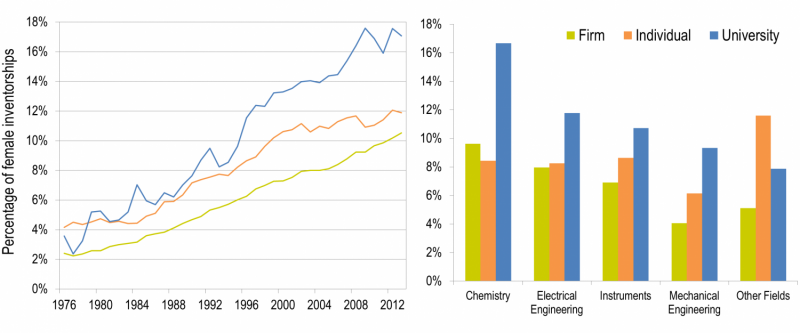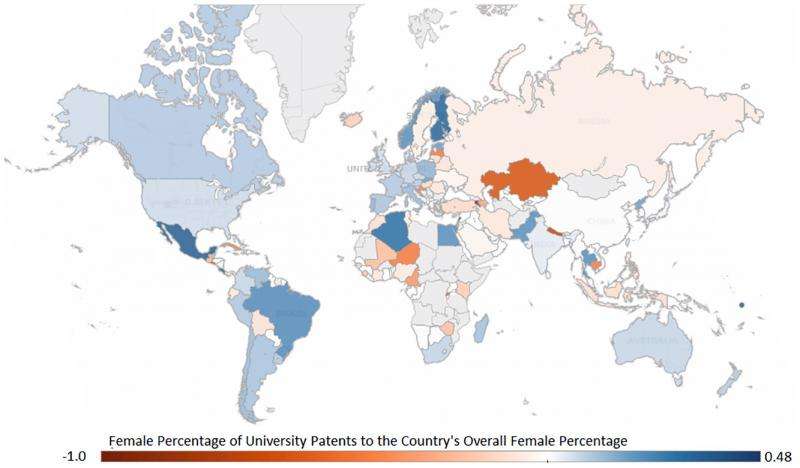Patent filings by women have risen fastest in academia

The number of women across the globe filing patents with the U.S. Patent and Trade Office over the past 40 years has risen fastest within academia compared to all other sectors of the innovation economy, according to a new study from Indiana University.
The analysis, which examined 4.6 million utility patents issued from 1976 to 2013, was led by Cassidy R. Sugimoto, an associate professor of informatics at the School of Informatics and Computing at IU Bloomington.
The results of "The Academic Advantage: Gender Disparities in Patenting" are reported online in the journal PLOS ONE.
"To find out that women are patenting at higher rates in academia compared to industry, government and individuals is a surprising discovery," Sugimoto said. "We had thought it might fall lower since patenting in still considered 'optional' in terms of promotion in academia, although it's increasingly encouraged."
The role of patenting at academic institutions has grown in significance since the passage of the Bayh-Dole Act in 1980, which transferred intellectual property revenue based on federally funded research discoveries from government to universities.
Sugimoto and collaborators found that from 1976 to 2013, the overall percentage of patents with women's names attached rose from an average of 2 to 3 percent across all areas to 10 percent in industry, 12 percent in individuals and 18 percent in academia.
The analysis also revealed that patents from women frequently included contributors from a wider variety of fields, suggesting women inventors were more collaborative and multidisciplinary.

"The relative success of large research universities in fostering women's innovation might be due in part to the unique emphasis placed on intellectual communities in academia," she said. "Women interested in entrepreneurship in industry may encounter a greater sense of isolation."
In addition, Sugimoto emphasized the important role played by university technology transfer offices in setting policies that encourage women's innovation.
"The IURTC is strongly committed to encouraging innovation among all faculty, including women," said Tony Armstrong, president and CEO of the IU Research and Technology Corp., which helps IU faculty transform their research into patents and spin-off companies. "Our office operates a number of efforts to educate faculty on topics such as intellectual property, patents and spinning off their discoveries as companies whose impact may be felt beyond the laboratory."
This outlook is important as Sugimoto's study also revealed a number of places where patent filing among women has room to improve. For instance, she said neither academic nor industrial nor government patents came close to reflecting women's current representation in science, technology, engineering and math—the fields most associated with patentable discoveries. Women make up one-third of all researchers in the STEM fields.
She also found the "impact score" assigned to patents with the names of women—calculated using the number of times these patents were cited in other filings—was much lower compared to patents with male names.
The numbers reflect similar findings to earlier research from Sugimoto on women and academic publishing, which found significantly lower citation rates for women.
Other statistics from the research include that patents with women's names did not exceed 2 percent of all patents from 1637 to the mid-1900s, and that a total of 42 countries, primarily in the Middle East and Africa, report no patents with women's names.
The proportional rate of patents with women's names was highest in Eastern Europe, Asia and several African countries, a result reflecting other research that found greater gender parity in communist and former-communist countries, Sugimoto said.
Overall, the IU study tracked female patent filers across 185 countries, all of whom filed their discoveries with the U.S. patent office.
In addition to IURTC, IU leads a number of efforts to encourage faculty innovation and women's success in STEM, including the recently established IU Center for Excellence for Women in Technology. The IU School of Informatics and Computing was also honored as one of three institutions to receive an inaugural National Center for Women & Information Technology Extension Services Transformation Award. These awards, sponsored by Google, recognize institutions with significant gains in women's enrollment and graduation rates.
More information: PLOS ONE, journals.plos.org/plosone/arti … journal.pone.0128000
Journal information: PLoS ONE
Provided by Indiana University



















